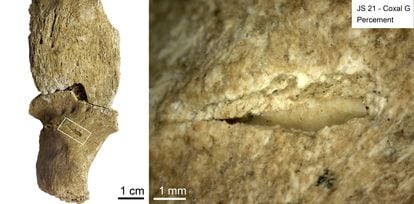Ancient cemetery shows how early humans dispensed indiscriminate violence 13,400 years ago
Forensic techniques applied to Jebel Sahaba, a prehistoric burial site in Sudan, shed new light on the death of men, women and children in inter-group battles during the Late Pleistocene
/cloudfront-eu-central-1.images.arcpublishing.com/prisa/QC4YRYBKWJB35JNMG2FVQIR4YM.jpg)
Early humans killed men, women and children indiscriminately and as a matter of course as long as 13,400 years ago, a study of a Paleolithic burial site carried out using modern forensic techniques has concluded. The majority of the wounds detected on the remains were caused by projectiles, which points more to attacks from other groups rather than violence within the community itself. The authors of the study also believe that the people buried at the site did not die in a single confrontation, but over the course of several separate attacks.
During the construction of Egypt’s Aswan Dam in the 1960s to control the seasonal flooding of the Nile, a cemetery containing the remains of 61 people was uncovered in Jebel Sahaba, just across the border in northern Sudan. Designated as Cemetery 117, the remains found there were transported to the United Kingdom before the water that now constitutes Lake Nasser made them inaccessible. Many of the remains bore marks of violence. There is evidence of battles between groups of early humans in Asia, Europe and Africa, but none as ancient as those discovered at Cemetery 117. Archeologists at the time considered the Jebel Sahaba site the earliest known example of a war between modern humans.
Today, researchers at the British Museum, where the remains are stored, and the Universities of Toulouse and Bordeaux have carried out fresh examinations of the skulls and hundreds of bones seeking any signs of violence. And they have identified many more than were previously recorded. The results of their research, published in the journal Scientific Reports, show that 67% of the people interred at Jebel Sahaba had wounds caused by a confrontation involving weapons. This represents a two-fold increase on the number of injuries of this type detected during the 1960s investigations. Furthermore, around 100 wounds have been found that techniques available at that time were unable to identify. Many of them still have splinters of sharpened stone points embedded in the bone.

The study’s lead researcher, Isabelle Crevecoeur, a paleontologist at the University of Bordeaux and a member of the French National Center for Scientific Research, confirms the increased number of victims at the site. “It is 73.7% of the women and 75% of the men. It shows that essentially women and men were attacked indiscriminately.” That percentage could be even higher, given that not all mortal wounds would have cut through to the bone or pierced the skull.
This new, more in-depth analysis provides fresh clues as to how inter-group violence was carried out in the late Stone Age. “When the location of the marks left by the projectiles and their frequency is compared, the only difference is in the fractures. Among the women, the majority of the scars are related to defensive injuries while in the men the fractures are in the bones of the hand. This type of wound is provoked by hand-to-hand combat and the differences could reflect an instinctive reaction in this situation, when the men are more likely to confront the attackers while the women might have been defending themselves,” says Crevecoeur.
Half of the children found at Cemetery 117 also had signs of violence on their remains. Although in some cases the injuries could have been caused accidentally, in the majority the wounds detected were caused by a weapon of some kind. “The instances of traumatic injury are mostly present in small children [those least equipped to defend themselves] and the marks left by projectiles are mainly on the skulls [which are weaker than those of adults to due to bone density],” notes Crevecoeur.
The forensic analysis also shows that around half of the injuries inflicted on the defenders were caused by arrows or spears. This backs the thesis of indiscriminate aggression from outside the group. For many years, several experts have maintained that the attack at Jebel Sahaba was an isolated incident. However, Crevecoeur and her colleagues say that there is sufficient evidence that members of this Late Pleistocene community were the victims of periodic ambushes and incursions. Backing this theory is the fact that many of the people found at Cemetery 117 had injuries that had already healed along with others that had not, which is to say that they had suffered previous attacks before the final blow that ended their lives was inflicted.
As well as the healed injuries from previous traumas, Crevecoeur gives other examples to support the conclusions of her team. On the one hand, several of the individual graves were reopened to bury another person years later. Neither were all the victims buried together at Jebel Sahaba. “When you have a burial related to a single event [such as a massacre or an epidemic], the portion of the population that dies is not the usual one you’d find in any other cemetery,” the paleontologist points out, in reference to the section of a society more likely to be killed during a conflict such as adults and older children. “Looking at the demographic profile of the cemetery, it does not coincide with a burial related to a single event, a sudden crisis of mortality. The profile of Jebel Sahaba is that of a normal cemetery.”
Why were these hunter-gatherers of the Nile Valley killed? Daniel Antoine, the curator of the Jebel Sahaba find at the British Museum, believes that a period of climate change spanning the end of the Pleistocene and the beginning of the Holocene, the current geological age, could have played a part. “Competition for resources due to a change in climate was in all likelihood the cause of these recurring conflicts,” a note from the museum states.
Around 67% of the people interred at Jebel Sahaba had wounds caused by a confrontation involving weapons
José Manuel Maíllo, a prehistory scholar at Spain’s distance learning university UNED, has researched other similar burial sites where violence has been detected such as at Nataruk, in Kenya. In his view, a causal link between climate change and the fatal confrontation at Jebel Sahaba has not been proven. “They give the explanation, a somewhat overused one, that climate was to blame for a lack of resources,” he says. In Maíllo’s opinion, researchers should focus on the root causes that could spark “a battle between groups of sedentary or semi-sedentary hunter-gatherers at a moment of climatic instability.”
Maíllo’s other main objection to a study he nonetheless considers interesting is whether Cemetery 117 is the result of a single war or if it was gradually filled as a result of successive battles. “In order to prove that it is a drawn-out action over time, it is necessary to date a significant sample of the remains or the graves. The radiometric dating carried out up to now at Jebel Sahaba is insufficient to back this hypothesis,” he states. Radiocarbon dating, meanwhile, does not allow researchers to pinpoint the exact date of death of every person interred at Cemetery 117.
As Maíllo notes: “The majority of empirical evidence of inter-group violence dates from the end of the Pleistocene to the beginning of the Holocene.” Jebel Sahaba and Nataruk are two examples of this type of violence between groups of hunter-gatherers. The key could lie in the fact that these two communities were no longer nomadic and they had access to a stable set of resources. “Both groups were of a semi-sedentary or sedentary nature and possibly had more delimited territories than the groups that preceded them.”
English version by Rob Train.

/cloudfront-eu-central-1.images.arcpublishing.com/prisa/GLUFWS63TRB4HCZ7UKQ74IG2TI.jpg)
/cloudfront-eu-central-1.images.arcpublishing.com/prisa/XSCEWMXKDBD4RHQS5SEJUZABOM.jpg)










































